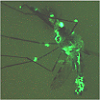Kevin Cheung
In a discovery of consequence for efforts to save Tasmanian devils in the wild, scientists have found some devils from north-west Tasmania are genetically different and potentially resistant to the deadly cancer threatening the species. The discovery by University of Sydney and University of Tasmania researchers will have implications for efforts to contain the spread of Devil Facial Tumour Disease (DFTD) which has decimated 70 per cent of the devil population since the first diagnosis in east Tasmania in 1996. Results from the collaboration, published in the latest edition of the journal Proceedings of the Royal Society B, describe levels of diversity in key immune genes in Tasmanian devils.
Lead author, University of Sydney Associate Professor Kathy Belov, from the Faculty of Veterinary Science, said the identification of a small number of genetically different devils in the north-west population opened exciting new research opportunities. “The majority of devils in Tasmania are immunological clones and therefore susceptible to DFTD. This study has identified a group of devils that are genetically different. We think these devils may be able to see the cancer cells as foreign and mount an immune response against them,” Associate Professor Belov said.
DFTD is a transmissible cancer that affects only Tasmanian devils and is spread by biting. It is characterised by large facial tumours which often spread to internal organs. The disease has decimated populations on the east coast where the disease was first detected, because of a lack of genetic diversity at key immune genes. A decade ago the Tasmanian devil was regarded as common but now it is listed as endangered at both a state and national level and extinction in the wild is considered to be a real possibility within 25-35 years.
Associate Professor Belov said the identification of the genetically different devils, may have implications for captive breeding if these devils are resistant to DFTD. She said the long term aim of the breeding program however, should still be to maintain as much genetic diversity as possible for future generations and that the insurance breeding program should continue unchanged.
Popular Science has been a leading source of science, technology and gadget news since 1872. With up-to-the minute latest space news, insightful commentary on the new innovations and concept cars ...if it's new or future technology you'll find it at popsci.com.au.
WW Media - Popular Science © 2010
Technology - DIY - Videos






